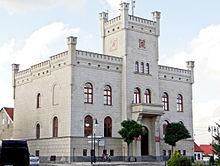Tudor style

As Tudor style (English. "Tudor style" ) or Tudor Gothic is in the English architecture of the last period of the Gothic style in transition to Renaissance during the reign of Tudor (1485-1603) indicates that seamlessly at the Perpendicular style joins.
Mark
Characteristic is the architecture, which adheres to late Gothic detail forms and which only hesitantly takes up elements of the Renaissance, so the Tudor arch is a squat form of the Gothic pointed arch . A "typical" Tudor facade is characterized by rectangular or polygonal ( derived from the octagon ) flanking turrets and bay windows , lancet windows, partly rectangular with a cross , partly with Tudor arches and often crenellated wall ends (also in churches), sometimes interrupted by triangular gables , sometimes lined up Triangular gables without battlements, as well as filigree chimney architectures on the roofs. Symmetry does not play a role in the early Tudor style, rather the diversity of the individual facade sections is emphasized.
A particularly striking feature of the Tudor style is the half-timbered architecture , which repeats the above-mentioned forms in wooden architecture. The asymmetrical aspect of timber construction is underlined by the different half-timbered forms of the individual floors and structures. The Tudor framework was characteristic of late medieval urban architecture in England, and is still visible today, especially in Chester .
Aftermath of the Tudor style
In the further development of the Tudor style (referred to in English art history as Elizabethan architecture , followed by Jacobin architecture ) the Gothic style elements, including the Tudor arch, declined. The facades are also becoming increasingly symmetrical.
Ultimately, elements of the Tudor Gothic style also survived the Baroque architecture of the British Isles. While Tudor was still being built in parallel to the "modern" style of Palladianism throughout the 17th century, Gothic in England experienced a renaissance as early as the 18th century when many castles and country houses were rebuilt or redesigned in Gothic Revival .
Tudor Revival
In historicism in the middle of the 19th century, the early Tudor style was taken up again in an eclectic form and was later spread in the former British colonies and on mainland Europe. Hotels and train stations , but also private residential buildings, were built in this New Tudor style. In English this is called Tudor revival or mock Tudor . An example of this is Friedrichshof Palace in Kronberg (Ts.), The main train station in Wroclaw and Kórnik Palace near Posen.
Important Tudor buildings
Tudor buildings in the British Isles
- King's College Chapel in Cambridge
- Henry VII Lady Chapel in Westminster Abbey London
- Hampton Court Palace south west of London
- Burghley House at Stamford
- Mount Edgcumbe House near Plymouth
New Tudor buildings on the European mainland
- the building of the Hanover Stock Exchange
- the town hall Peitz in Brandenburg
- the town hall building in Passenheim
- the main railway station of Wroclaw (Wrocław Główny), Lower Silesia , Poland
- Neudeck Castle in Upper Silesia , Poland (demolished 1961)
- Anif Castle near Salzburg , Austria
- Aurich Castle in East Frisia
- Babelsberg Palace in Potsdam
- Cecilienhof Palace in Potsdam
- Derneburg Castle near Hildesheim
- Eckberg Castle in Dresden
- Frauenberg Castle in Hluboká nad Vltavou , Czech Republic
- Friedrichshof Palace in Kronberg im Taunus (widow's seat of the "forgotten Empress Friedrich ")
- Herdringen Castle near Arnsberg
- Erdmannsdorf Castle in Silesia, Poland
- Hrádek u Nechanic Castle near Hradec Králové , Czech Republic
- Kittendorf Castle in Mecklenburg
- Kórnik Castle near Poznan
- Letzlingen Hunting Lodge and Letzlingen Castle Church in Letzlingen , Saxony-Anhalt
- Lubowitz Castle in Lubowitz
- Moyland Castle on the Lower Rhine
- Oberlangenstadt Castle in Upper Franconia
- Reichenow Castle in Reichenow-Möglin , Brandenburg
- Tjolöholm Castle near Kungsbacka , Sweden
- Wolfsberg Castle , Carinthia , Austria
- Compil residence in Bozen , South Tyrol , Italy

literature
- P. W. Hartmann: The great art dictionary




